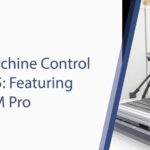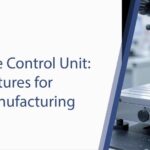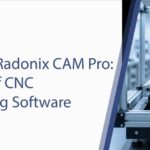Industrial CNC Control Systems: The Backbone of Modern Manufacturing
Introduction: Precision and Speed in Modern Manufacturing
In the world of modern manufacturing, precision and speed are non-negotiable. At the heart of every Computer Numerical Control (CNC) machine lies a sophisticated piece of technology that makes this possible: the industrial CNC control systems.
These are not just simple computers; they are the highly specialized, robust brains that interpret design files and translate them into the precise, coordinated movements of a machine’s motors, tools, and spindles.
For decades, the evolution of manufacturing has been directly tied to the advancements in industrial CNC control systems.
They are the key to unlocking higher productivity, tighter tolerances, and more complex part geometries. Whether it’s a 3-axis milling machine or a 5-axis turning center, the performance, reliability, and capability of the entire system are dictated by its control.
At Radonix, we understand this critical relationship and specialize in providing cutting-edge control solutions that empower manufacturers to achieve new levels of excellence.
This article will take a deep dive into what defines industrial CNC control systems, explore their essential components and functions, and explain why choosing the right system is one of the most strategic decisions a business can make.
What Are Industrial CNC Control Systems?
An industrial CNC control system is a dedicated computer and software package that serves as the command center for a CNC machine.
It receives a program—typically in the form of G-code and M-code—and directs the machine’s axes of motion, spindle speed, tool changes, and other functions to create a physical part from a digital design.
Unlike a consumer PC, these systems are built to withstand the harsh conditions of a factory floor.
They are enclosed in durable, sealed housings to protect against dust, coolant, and electrical interference.
The hardware and software are optimized for real-time performance, ensuring that the machine’s movements are executed with nanosecond-level accuracy and repeatability.
Core Functions of CNC Control Systems
- Program Interpretation: Reading and processing G-code and M-code to understand the desired tool path and machine actions.
- Motion Control: Commanding servo or stepper motors to move the machine’s axes (X, Y, Z, A, B, etc.) with extreme precision.
- Spindle Control: Managing the speed and direction of the cutting tool’s rotation.
- Input/Output (I/O) Management: Interacting with various machine components like limit switches, coolant pumps, and tool changers.
- Human-Machine Interface (HMI): Providing an interface for the operator to load programs, monitor status, and intervene when necessary.
The synergy of these functions is what makes industrial CNC control systems the cornerstone of automated manufacturing.
The Key Components of Industrial CNC Control Systems
A modern CNC control system is a complex integration of hardware and software. Understanding its key components is essential to appreciating its role.
Central Processing Unit (CPU)
This is the brain of the system, a high-performance computer processor that executes the CNC program. Unlike a standard CPU, it’s designed for real-time operating systems, meaning it can handle critical tasks without delay, which is crucial for safety and accuracy.
CNC Kernel / Motion Controller
This specialized hardware and software directly manage the machine’s motion. It takes the digital data from the CPU and translates it into electrical signals that drive the servo motors. This is where high-speed interpolation—the calculation of a smooth tool path between points—takes place. The precision of the motion controller is a primary factor in the final part’s quality.
Servo Drives and Motors
These are the muscles of the machine, responsible for moving the axes. The servo drive receives commands from the motion controller and supplies the precise amount of electrical current to the servo motor. The motor then moves to the exact commanded position, with real-time feedback loops ensuring there are no positioning errors.
Operator Panel & HMI
This is the user-facing part of the industrial CNC control systems. It typically includes a high-resolution screen, a keyboard, and a series of physical buttons. The HMI is where operators can load programs, monitor process variables, and manage machine settings. An intuitive and user-friendly HMI is crucial for reducing operator error and increasing efficiency.
I/O System
This includes all the inputs and outputs that connect the control system to the machine’s physical components. It manages signals from safety switches, tool changers, coolant pumps, and other accessories.
The seamless integration of these components is what defines a robust and reliable set of industrial CNC control systems.
The Strategic Importance of Choosing the Right Industrial CNC Control Systems
The decision to choose a particular CNC control system is one of the most impactful a business can make. It affects everything from productivity and part quality to flexibility and future growth.
Productivity and Efficiency
An advanced control system can significantly reduce cycle times. With faster processing, superior motion control, and optimized algorithms, it can execute complex tool paths more quickly and smoothly. This increased efficiency translates directly into higher throughput and a faster return on investment.
Part Quality and Precision
The accuracy of the control system is a direct measure of the accuracy of the finished part. A high-quality system minimizes interpolation errors, eliminates backlash, and provides superior motion stability, all of which contribute to tighter tolerances and a better surface finish. When precision is paramount, investing in the right industrial CNC control systems is essential.
Operator Experience and Ease of Use
A well-designed control system with an intuitive HMI can drastically reduce the learning curve for new operators. Features like graphical interfaces, real-time monitoring, and built-in help functions make programming and operating the machine easier and safer. This leads to fewer errors and higher job satisfaction.
Advanced Features and Capabilities
Modern industrial CNC control systems offer a host of advanced features that go beyond basic motion control. These include:
- 5-Axis and Multi-Axis Machining: The ability to control multiple axes simultaneously for complex part geometries.
- Adaptive Control: Systems that can automatically adjust feed rates based on cutting forces and spindle load.
- Digital Twins and Simulation: The capability to simulate the entire machining process in a virtual environment before a single cut is made.
- Data Connectivity (Industry 4.0): Integration with factory networks, allowing for remote monitoring, data logging, and seamless communication with other systems like MES and ERP.
Future-Proofing and Longevity
Investing in a state-of-the-art control system ensures that your machine can handle future challenges. An open-architecture system, for example, can be more easily updated and integrated with emerging technologies, extending the useful life of your CNC machinery.
Key Considerations When Selecting Industrial CNC Control Systems
With a variety of control systems on the market, choosing the right one requires careful evaluation. Here are some key factors to consider:
- Application Requirements: What are you machining? A 3-axis mill for simple parts has different control needs than a complex 5-axis machine for aerospace components. Match the control system’s capabilities to your specific application.
- Ease of Programming: Does the control system support your preferred programming methods (e.g., G-code, conversational programming)? Is the user interface easy to navigate and understand?
- Machine Compatibility: The control system must be compatible with your CNC machine’s hardware, including the motors, drives, and feedback systems.
- Reliability and Durability: Look for a system built for industrial environments, with a robust design and a track record of reliability. Downtime is expensive, and a reliable control system minimizes this risk.
- Technical Support and Service: A good control system is backed by a responsive and knowledgeable support team. At Radonix, we pride ourselves on providing exceptional technical support to ensure your operations run smoothly.
- Integration and Connectivity: For businesses embracing Industry 4.0, the ability of the control system to connect with other factory systems is a crucial factor.
The Radonix Advantage: Your Partner in Control
At Radonix, we specialize in providing state-of-the-art industrial CNC control systems that empower manufacturers to achieve new levels of precision and efficiency. Our solutions are designed to be robust, intuitive, and feature-rich, providing you with a competitive edge in today’s demanding market.
Our expertise extends beyond just the hardware. We offer:
- Tailored Solutions: We work closely with you to understand your specific needs and provide a control system that is perfectly suited to your applications.
- Seamless Integration: Our control systems are designed for easy integration with a wide range of CNC machines, from new builds to retrofits.
- Unmatched Support: Our team of experienced engineers provides comprehensive support, from installation and training to ongoing maintenance, ensuring that your investment in industrial CNC control systems delivers maximum value.
Conclusion: Investing in the Future of CNC Manufacturing
The success of your CNC operations depends on the quality of your control system. By choosing a powerful and reliable solution, you are not just buying a component; you are investing in the future of your manufacturing capabilities.
Discover the difference that superior control can make.
Contact Radonix today to learn more about our industrial CNC control systems and find the perfect solution for your business.
Contact Us:
- E-Mail: info@radonix.com
- Phone: +90 (553) 920 5500








